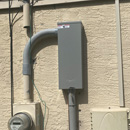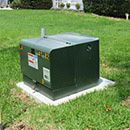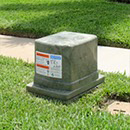
|
|
|
|
|
|
Our Storm Protection Plan identifies and prioritizes overhead lines that will see the biggest improvement in reliability after extreme weather events. Currently, about 50% of Tampa Electric's power lines are underground, mostly in areas of new construction, which were paid for by developers. We strive to have 75 miles of targeted overhead lines converted to underground every year.
When we identify targeted overhead lines that need to be undergrounded, we begin a comprehensive outreach process to work cooperatively with property owners and neighborhoods on a plan to underground those portions of the circuit.
Here are the stages of undergrounding power lines:
- Evaluation: A data-driven process to identify overhead lines most prone to outages.
- Design: A proposed route for new underground lines and an assessment of the current meter base to identify if a meter base adapter is needed.
- Meter Base Adapters may need to be added so your current meter can accept the underground cables. Our team will work with you to determine the best meter base adapter for your home. Sizes and configurations may vary.
- Easements: We will secure necessary easements along the proposed underground route, which will allow us to install and maintain equipment on the route.
- Scheduling and Site Preparation: Stakes and flags will mark the proposed route and equipment placement. These markings will show the existing public and private underground utilities.
- Construction: Where possible, cable will be installed using minimal-impact directional-boring technology, and the transformer and/or pedestal (or handhole) will be installed.
- Padmounted transformers allow underground connections to be maintained safely. The location is ultimately determined by the electric load and route. The average size is 40" wide x 36" deep x 34" high.
- Pedestals (or Handholes) may also be used to reliably extend the underground system. The average size is 23" wide x 15" deep x 18" high.
- Conversion: To energize the new underground cable, there will be a scheduled outage and installation of a meter base adapter, if needed.
- Overhead Removal: The overhead electric lines will be removed.
- Property Restoration: Once all other phases are complete, our crews will remove poles where possible and will restore damaged property
Please watch our video to learn how:
- SPP benefits your neighborhood.
- We communicate with you about SPP.
- Power lines are placed underground, and why.
- Your property is restored when our work is complete.
Underground Lines FAQ
A. No. The law requires utilities to outline a 10-year plan to strengthen our electric system to better withstand extreme weather events, to enhance customer reliability and to reduce customer outage times and restoration costs. Installing certain power lines underground can be a portion of the plan.
A. Today, about 50 percent of Tampa Electric's power lines are underground, mostly in areas of new construction and paid for by the developers. The Public Service Commission requires utilities to provide power at the lowest possible cost to customers, which in most cases is overhead construction.
A. Tampa Electric partnered with an independent engineering firm to perform an extensive analysis to identify each overhead line's vulnerability to extreme weather events. Then, we determined the cost and customer benefit of converting those lines to underground, which helped to prioritize the projects. The plan calls for 75 - 100 miles to be converted to underground every year. Once a final assessment is made, Tampa Electric will identify areas and neighborhoods that will be undergrounded, and we will begin a comprehensive outreach process to work cooperatively with property owners and neighborhoods on a plan to underground those portions of the circuit. Circuits will be prioritized to ensure work – and customer benefits – occur simultaneously in each area.
A.Tampa Electric will contact you if your neighborhood will be affected by the storm protection plan this year. Tampa Electric has more than 6,000 miles of overhead power lines, and our work will focus on the lines that can have the biggest improvement for reliability after extreme weather.
A. In the early phases of SPP, Tampa Electric will underground almost exclusively lateral lines serving homes and businesses in neighborhoods. Mainline overhead distribution "feeder" circuits bringing power to neighborhoods will be prioritized for separate hardening activities.
As an overview of our system; high-voltage power lines carry electricity from power stations to substations, and distribution lines deliver the electricity to our customers. The largest of the distribution lines – primary or main feeder lines – carry power from substations to neighborhoods. Lateral lines then bring electricity into neighborhoods, to homes and businesses.
While the work to strengthen the system will include undergrounding in some neighborhoods, the lines serving the neighborhoods may still remain overhead.
A. Yes. The SPP improves system reliability and shortens the time for restoring service to all customers following extreme weather events. As a result, all customers will benefit from the SPP and share the costs of the program.
A. The time required will vary among projects. Property owners and neighborhood organizations will be advised what to expect as a project is planned and executed.
A. There will be a planned outage associated with the work in order to make the necessary connections. Property owners will be notified in advance of a scheduled outage. An outage to make the final conversion from overhead service to underground is typically four hours or less.
A. Tampa Electric does not compensate customers for easements required for undergrounding. If we are not able to secure the necessary easements or land rights, we will look for other viable solutions.
A. A project team will meet with you to discuss the proposed project plan and layout. Underground lines enter ground-level, pad-mounted transformers from below, keeping connections safely inside and out of view. The location of each pad-mounted transformer is determined by the electric load calculations and the route of the underground lines. We will adapt the meter base at the customer's home to accept cables from underground, using a meter-base adapter.
A. The focus of Tampa Electric's undergrounding projects in the SPP is to convert overhead electric power lines to underground that serve an area or neighborhood, including homes and other existing electrical services, such as street lights.
A. To minimize disruption to landscaping, Tampa Electric plans to use directional drilling instead of open trenching or digging. We will work with property owners as we determine the acceptable path for underground lines.
A. Respecting and restoring property are top priorities. We work with our customers during and after construction to minimize impact and inconvenience. After we complete our work, Tampa Electric will restore any damaged property.
A. Some of our telecommunications partners also own poles that other utilities, including Tampa Electric, use. Tampa Electric will work with telecommunications and cable companies to explore installing their lines underground at the same time. Each project will be evaluated separately by the telecommunications and cable companies. If the telecommunications equipment remains overhead, the poles will need to remain in place. The project team leader can provide details about the status of the poles for each project area.
A. The use of electricity in our everyday lives creates electric and magnetic fields (EMF) near everything from power lines to your computer to your microwave. Studies by international and federal health and regulatory bodies have been conducted for decades and no conclusive evidence has linked low frequency EMF exposure to health issues. Tampa Electric's equipment complies with the Florida Department of Environmental Protection standards.
Tampa Electric encourages you to learn more about EMF here:




